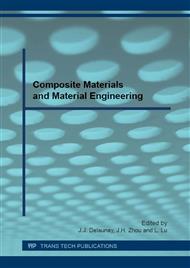[1]
X. -Z. Gao, H. -J. Liu, F. Cheng, and Y. Chen, Thermoresponsive polyaniline nanoparticles: Preparation, characterization, and their potential application in waterborne anticorrosion coatings, Chem. Eng. J., vol. 283, p.682–691, (2016).
DOI: 10.1016/j.cej.2015.08.015
Google Scholar
[2]
a. F. Baldissera, J. F. Souza, and C. a. Ferreira, Synthesis of polyaniline/clay conducting nanocomposites, Synth. Met., vol. 183, p.69–72, (2013).
DOI: 10.1016/j.synthmet.2013.09.022
Google Scholar
[3]
J. Stejskal and R. G. Gilbert, polyaniline . Preparation of a conducting polymer ( IUPAC Technical Report ) Polyaniline . Preparation of a conducting polymer ( IUPAC Technical Report ), vol. 74, no. 5, p.857–867, (2006).
DOI: 10.1515/iupac.74.0085
Google Scholar
[4]
X. Zhang, X. Wu, L. Yu, B. Yang, and J. Zhou, Highly sensitive and selective polyaniline thin-film sensors for detecting SF6 decomposition products at room temperature, Synth. Met., vol. 200, p.74–79, (2015).
DOI: 10.1016/j.synthmet.2014.12.033
Google Scholar
[5]
E. Akbarinezhad, M. Ebrahimi, and F. Sharif, Preparation of polyaniline and self-doped polyaniline–clay nanocomposites in supercritical CO2: Synthesis and conductivity study, Synth. Met., vol. 162, no. 21, p.1879–1886, (2012).
DOI: 10.1016/j.synthmet.2012.07.023
Google Scholar
[6]
M. Oyharçabal, T. Olinga, M. P. Foulc, and V. Vigneras, Polyaniline/clay as nanostructured conductive filler for electrically conductive epoxy composites. Influence of filler morphology, chemical nature of reagents, and curing conditions on composite conductivity, Synth. Met., vol. 162, no. 7–8, p.555–562, (2012).
DOI: 10.1016/j.synthmet.2012.02.011
Google Scholar
[7]
S. Pande, S. H, M. D. Bedre, R. Bhat, R. Deshpande, and a. Venkataraman, Synthesis, Characterization and Studies of PANI-MMT Nanocompoisites, Nanosci. Nanotechnol., vol. 2, no. 4, p.90–98, (2012).
DOI: 10.5923/j.nn.20120204.01
Google Scholar


